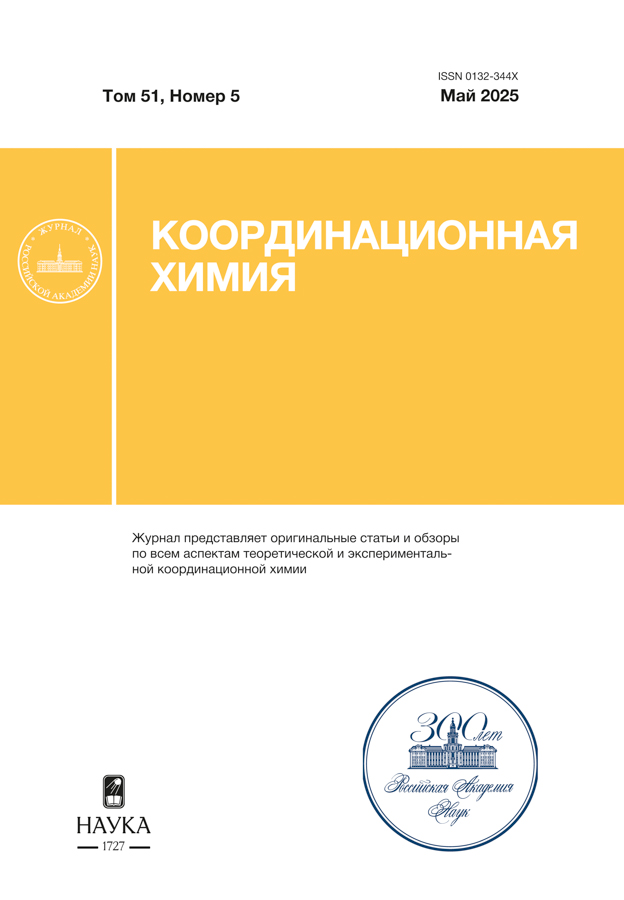Synthesis of Nickel(II) complex with 2,6-dichlorophenyl-substituted pyridylpyrazole
- 作者: Nikovskii I.A.1, Safiullina E.S.1, Nelyubina Y.V.1,2
-
隶属关系:
- Nesmeyanov Institute of Organoelement Compounds, Russian Academy of Sciences
- Moscow Institute of Physics and Technology
- 期: 卷 51, 编号 5 (2025)
- 页面: 289-297
- 栏目: Articles
- URL: https://cardiosomatics.orscience.ru/0132-344X/article/view/685145
- DOI: https://doi.org/10.31857/S0132344X25050016
- EDN: https://elibrary.ru/KWFZVH
- ID: 685145
如何引用文章
详细
The mononuclear nickel(II) complex [L2Ni(CH3OH)]Cl (I) was synthesized by the interaction of new ligand 2-(2,6-dichlorophenyl)-5-(pyridin-2-yl)-2,4-dihydro-3H-pyrazol-3-one (L) with nickel(II) chloride. The solvate of complex I with methanol [L2Ni(CH3OH)]Cl·3CH3OH and the initial ligand L were characterized by X-ray diffraction analysis (CCDC № 2314989 (I), 2314988 (L)). It was observed that ligand L exists in the pyrazolone form based on 1H NMR data, whereas in complex I, it is found in the pyrazolol form according to X-ray diffraction data. Complex I is a unique example of a pyrazolol complex in which the oxygen atom does not engage in coordinating with the transition metal ion to create the coordination polymer.
全文:
作者简介
I. Nikovskii
Nesmeyanov Institute of Organoelement Compounds, Russian Academy of Sciences
编辑信件的主要联系方式.
Email: igornikovskiy@mail.ru
俄罗斯联邦, Moscow
E. Safiullina
Nesmeyanov Institute of Organoelement Compounds, Russian Academy of Sciences
Email: igornikovskiy@mail.ru
俄罗斯联邦, Moscow
Yu. Nelyubina
Nesmeyanov Institute of Organoelement Compounds, Russian Academy of Sciences; Moscow Institute of Physics and Technology
Email: igornikovskiy@mail.ru
俄罗斯联邦, Moscow; Dolgoprudny, Moscow Region
参考
- Khusnutdinova J.R., Milstein D. // Angew. Chem. Int. Ed. 2015. V. 54. P. 12236. https://doi.org/10.1002/anie.201503873
- Kumar A., Daw P., Milstein D. // Chem. Rev. 2021. V. 122. P. 385. https://doi.org/10.1021/acs.chemrev.1c00412
- Peris E., Crabtree R.H. // Chem. Soc. Rev. 2018. V. 47. P. 1959. https://doi.org/10.1039/C7CS00693D
- Wodrich M.D., Hu X. // Nat. Rev. Chem. 2017. V. 2. P. 0099. https://doi.org/10.1038/s41570-017-0099
- Gunanathan C., Milstein D. // Acc. Chem. Res. 2011 V. 44. P. 588. https://doi.org/10.1021/ar2000265
- Frey M. // ChemBioChem. 2002. V. 3. P. 153. https://doi.org/10.1002/1439-7633(20020301)3:2/ 3<153::AID-CBIC153>3.0.CO;2-B
- Varela-Álvarez A., Musaev D.G. // Chem. Sci. 2013. V. 4. P. 3758. https://doi.org/10.1039/C3SC51723C
- Thenarukandiyil R., Paenurk E., Wong A. et al. // Inorg. Chem. 2021. V. 60. P. 18296. https://doi.org/10.1021/acs.inorgchem.1c02925
- Lindner R., van den Bosch B., Lutz M. et al. // Organometallics. 2011. V. 30. P. 499. https://doi.org/10.1021/om100804k
- Ben-Ari E., Leitus G., Shimon L.J. et al. // J. Am. Chem. Soc. 2006. V. 128. P. 15390–15391. https://doi.org/10.1021/ja066411i
- Yang X., Hall M.B. // J. Am. Chem. Soc. 2010. V. 132. P. 120. https://doi.org/10.1021/ja9041065
- Scharf A., Goldberg I., Vigalok A. // J. Am. Chem. Soc. 2013. V. 135. P. 967. https://doi.org/10.1021/ja310782k
- Elsby M.R., Baker R.T. // Chem. Soc. Rev. 2020. V. 49. P. 8933. https://doi.org/10.1039/D0CS00509F
- Roussel R., DeGuerrero M.O., Spegt P. et al. // J. Heterocycl. 1982. V. 19. P. 785–796. https://doi.org/10.1002/jhet.5570190416
- Frank J., Katritzky A.R. // J. Chem. Soc., Perkin Trans. 2. 1976. P. 1428. https://doi.org/10.1039/P29760001428
- Moore C.M., Dahl E.W., Szymczak N.K. // Curr. Opin. Chem. Biol. 2015. V. 25. P. 9. https://doi.org/10.1016/j.cbpa.2014.11.021
- Al-Otaibi J.S. // SpringerPlus. 2015. V. 4. P. 1. https://doi.org/10.1186/s40064-015-1363-2
- Pietrzycki W.A., Sepioł J., Tomasik P. et al. // Bull. Soc. Chim. 1993. V. 102. P. 709. https://doi.org/10.1002/bscb.19931021105
- Langer R., Diskin-Posner Y., Leitus G. et al. // Angew. Chem. 2011. V. 123. P. 10122. https://doi.org/10.1002/anie.201104542
- Langer R., Leitus G., Ben-David Y. et al. // Angew. Chem. Int. Ed. 2011. V. 50. P. 2120. https://doi.org/10.1002/anie.201007406
- Srimani D., Ben-David Y., Milstein D. // Angew. Chem. Int. Ed. 2013. V. 52. https://doi.org/10.1002/ange.201300574
- Dupau P., Tran Do M.L., Gaillard S., Renaud J.-L. // Angew. Chem. Int. Ed. 2014 V. 53. P. 13004. https://doi.org/10.1002/anie.201407613
- Zell T., Milstein D. // Acc. Chem. Res. 2015. V. 48. P. 1979. https://doi.org/10.1021/acs.accounts.5b00027
- Polezhaev A.V., Chen C.H., Kinne A. et al. // Inorg. Chem. 2017. V. 56. P. 9505. https://doi.org/10.1021/acs.inorgchem.7b00785
- Kuwata S., Ikariya T. // Chem. Comm. 2014. V. 50. P. 14290. https://doi.org/10.1039/C4CC04457F
- Pavlov A.A., Aleshin D.Y., Nikovskiy I.A. et al. // Eur. J. Inorg. Chem. 2019. V. 2019. P. 2819. https://doi.org/10.1002/ejic.201900432
- Tasker S.Z., Standley E.A., Jamison T.F. // Nature. 2014. V. 509. P 299. https://doi.org/10.1038/nature13274
- Chen F., Di Y.Y., Zhang G. // J. Chem. Soc. Pak. 2023. V. 45. P. 19. https://doi.org/10.52568/001191/JCSP/45.01.2023
- Nikovskiy I., Polezhaev A., Novikov V. et al. // Chem. Eur. J. 2020. V. 26. P. 5629. https://doi.org/10.1002/chem.202000047
- Strunin D.D., Nikovskii I.A., Dan’shina A.A. et al. // Russ. J. Coord. Chem. 2024. V. 50. P. 384. https://doi.org/10.1134/S1070328424600645
- Sheldrick G.M. // Acta Crystallogr. A. 2008. V. 64. P. 112. https://doi.org/10.1107/S0108767307043930
- Dolomanov O.V., Bourhis L.J., Gildea, R.J. et al. // J. Appl. Crystallogr. 2009. V. 42. P. 339. https://doi.org/10.1107/S0021889808042726
- Demaison J., Császár A.G. // J. Mol. Struct. 2012. V. 1023. P. 7. https://doi.org/10.1016/j.molstruc.2012.01.030
- Constable E.C., Housecroft C.E. // Molecules. 2019. V. 24. P. 3951. https://doi.org/10.3390/molecules24213951
- Teratani T., Koizumi T.A., Yamamoto T. et al. // Inorg. Chem. Commun. 2011. V. 14. P. 836. https://doi.org/10.1016/j.inoche.2011.03.001
- Crabtree R.H. // New J. Chem. 2011. V. 35. P. 18. https://doi.org/10.1039/C0NJ00776E
补充文件

















